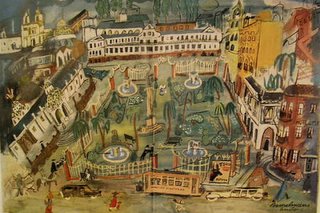
The Donkey Inside. Ludwig Bemelmans
Ludwig Bemelmans is most famous for his wonderfully illustrated children's book series based on the character Madeline. This is one of his non-fiction books for adults based upon his travels in South America.
Originally published in 1941, The Donkey Inside contains chapters that originally appeared in Town & Country, Vogue, Globe, and The New Yorker. Presented as a trip to Ecuador, this book is actually based on notes taken during several voyages through South America. Bemelmans says: "In a sense it is a portrait of that continent, from Chile to the Panama Canal, but it is focused on Ecuador, because there I found, in stronger outline than anywhere else, the things particular to South America." He claims that the characters in the book are by and large amalgams put together from several folks "to spare the reader the fatigue of meeting too many people."
As a tourist, Bemelmans is the outsider looking in. His depiction of the native population is of a servant class to his main characters: the rich Ecuadorians and emigrants from Europe. His focus on the rich and Europeans makes this book an interesting contrast to Ernesto Che Guevera's Motorcycle Diaries, written 10 years later by a native South American, which has a much more insightful and sympathetic view of the indigenous population. Both books are based on journals of trips along the west coast of South America.
My favorite chapter is called "Prison Visit" where Bemelmans lies his way into Pichincha Prison in Quito. He has heard such terrible stories of conditions there, but the reality is that it is the most idyllic of situations where prisoners play music, paint their cells, and earn wages for their work that pays for their keep, provides them and their families with spending money, and creates a nest-egg for their release. The warden is portrayed as concerned and respectful, and the prisoners are grateful for the solicitous care.
I found that Bemelmans is great at telling stories and describing people's behavior. Yet he relies on his illustrations to describe places and the environment, and the reader comes away with a limited view of the place. The book is illustrated with four two-page color illustrations and line drawing end papers in the distinctive Bemelmans style. One of the paintings, however, is a portrayal of Luchow's Restaurant in New York City that he dreams about when the local food gets monotinous.

This description of a classist society before World War II may not appeal to most modern readers, but the wonderful stories that Bemelemans tells and the characters that he creates are eternal. Those who choose to read this book will be rewarded with something much more than a travelogue; they will find timeless stories set in a quaint and idyllic country.

No comments:
Post a Comment